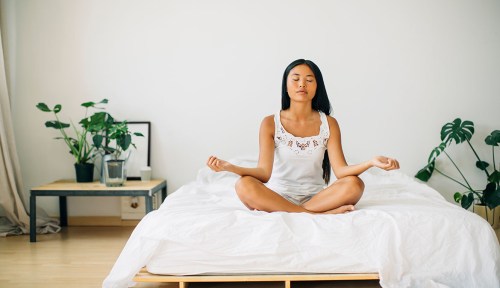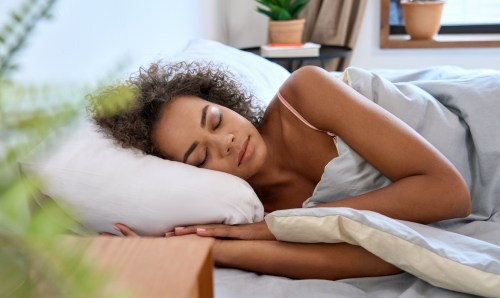Savasana is the best part of any yoga practice. Yes, I said it (and secretly, I’m pretty sure we all know it’s true). Who doesn’t love the feeling of lying with back grounded to the floor, feeling all of your—now stretched and lengthened—muscles recover and relax? The frustration ensues when you simply can’t achieve that same level of relaxation and release when you’re tossing and turning in bed actually trying to fall asleep. Why can’t it be as easy as it is on the mat? It is with yoga optimized for sleep.
Experts in This Article
personal trainer and founder of the app Emily Skye FIT
ANFT-certified nature and forest therapy guide, Ayurvedic health counselor, and Kripalu Yoga instructor
Megan Kearney is a creative vinyasa and thoughtful movement teacher who emphasizes the mind/body connection.
Michele Pernetta is the Founder and Chief Instructor at Fierce Grace, a Yoga Alliance Senior Teacher (UK and USA), and a Certified Ashtanga Vinyasa teacher.
yoga instructor
naturopathic physician in Arizona
yoga instructor, health coach, and reiki master
“Sleep is a function of the parasympathetic nervous system, the system devoted to rest and digestion,” says Katie Hagel, 1,000-hour certified instructor at Kripalu Center for Yoga and Health. “Not surprisingly, sleep onset and yoga are both associated with an increase in parasympathetic activity.” In other words, yoga, like your eight hours, calms the body down and unwinds stress. It’s basically the equivalent of a back rub for your nervous system. We talked to Hagel and a few other experts and instructors to help explain the benefits of yoga for sleep and provide a few different poses to do at home that will have you snoozing soundly in no time.
What are the health benefits of yoga for sleep?
1. It balances the nervous system
Joi Wheatley, a yoga instructor at New York City’s Stretch Relief studio, says that “the asana practice of yoga harmonizes the mind and body. So when we practice, the nervous system is balanced and mental and physical knots are released. When we are calmer, the body can come into a rest state easily.”
2. It can make you fall asleep faster
A growing body of research is finally backing up the 10,000 years-long relationship between yoga and rest. A 2013 study conducted on people 65 years or older found that participants who practiced yoga had better overall sleep quality, as well as fewer instances of disturbed sleep, and fell asleep more quickly. And yet more research found that people with chronic insomnia slept better with consistent practice.
3. It gives you a moment of “Me” time before bed to unwind
According to Emily Skye, who just launched a yoga section on her app, Emily Sky FIT, says that ” even a short slow flow style practice…is a way to let go of everything that is weighing you down before your head hits the pillow.” Thara Natalie Prashad, a certified yoga teacher and health coach from the Institute of Integrative Nutrition, adds that practicing restorative yoga before bed is a beneficial way to deliver more oxygen to the brain and bring the body into a state of stillness. It calms the nervous system, brings circulation to the head, and certain poses even produce serotonin and melatonin to promote better relaxation and sleep.
4. It releases muscle tension
Because yoga combines mindful movement with intentional breath, the combination can help your physical body relax as it unwinds your mind. “The movements or asanas provide an opportunity to modulate connective tissue heath. Yoga positions stretch long chains of muscles and fascia which can calm the nervous system which is largely involved in how we feel physically. Poor posture and muscle conditioning in addition to emotional stress contribute to everyday aches and pains as well as chronic pain conditions such as fibromyalgia and spondylosis,” explains Sarah Trahan, NMD, staff physician at the Neil Riordan Center for Regenerative Medicine who focuses on improving health through a natural approach.
Below, our favorite yoga instructors and experts bring you a pre-bed practice to complete on your mat or your bed to ease you into a long night’s rest.
Want to try yoga for sleep? These poses and meditations will get you started
1. Child’s pose (Balasana)
- 1.Come to tabletop pose: hips over knees and shoulders over wrists.
- 2.Take a block—or a pillow—and place it in between your hands.
- 3.Sink your hips back towards your heels, toes together, knees wide.
- 4.Rest your forehead on the block and extend your arms out in front of you, elbows resting on the floor.
- 5.Breathe down and into your belly and feel your belly expand against your thighs.
- 6.Exhale fully and completely, releasing your belly.
- 7.Take a few more breaths in this way and then welcome the breath into the back body, including the kidney area and the back of the heart.
- 8.Let the breath slide up and down the spine. Stay in this pose for one to three minutes, as long as you are comfortable.
The sleep benefit: Placing the block beneath your head creates a myofascial release for the muscles of the face that are often holding tension from, you know, everything you do during the day.
2. Sphinx pose (Salamba Bhujangasana)
- 1.Slither forward onto your belly, drawing your elbows under your shoulders to prop your body up.
- 2.Relax your shoulders, glutes, and back.
- 3.Let everything drape to the floor.
The sleep benefit: “This will help open the front line of the body and gently stimulate the adrenal glands,” says Megan Kearney, yoga teacher, and therapeutic specialist with Yoga Medicine.
3. Pigeon pose (Kapotasana)
- 1.From downward dog, draw your right knee forward and place it between your hands. “You may slide the right knee closer to your right wrist and guide your right foot in front of your left hip, never forcing, never straining, going only so far as is safe for your right knee,” says Hagel.
- 2.Keep your hips square to the front of the room. On an inhale, bring your hands underneath your shoulders and lift your heart forward and up, elongating your spine and arching your upper back. Taking all of that length with you, fold forward towards the earth. Your forehead can rest on stacked fists, or you can rest your forehead on the floor and extend your arms out on the floor in front of you. You can also rest your forehead on a block.
- 3.Uncurl your back toes. Notice what it is like to explore this shape with your breath, focusing on the back body, the right hip and the belly pelvis.
- 4.Breathe, relax, and deepen into the pose. Sustain for one to three minutes.
- 5.To release, bring the hands back under your shoulders and press up to down dog or table.
- 6.Repeat on the left side.
The sleep benefit: Your hips hold a day’s worth of tension from sitting. Stretch it out.
4. Supported bridge pose (Setu Bandha)
- 1.Roll onto your back. Bend your knees and plant your feet hip-width apart, directly underneath your knees, so that your shin bones are vertical.
- 2.Bring your arms down alongside your body, palms facing down. Avoid letting your knees splay out to the sides.
- 3.Take a block and place it on its lowest setting directly under your sacrum, the bony part of your waist. Let the block receive the weight of your hips.
- 4.Breathe down and into your belly, and draw the inhale up from your belly to your ribs and all the way up to your chest. As you exhale, send the breath down from your chest to your belly.
- 5.Continue to breathe in this way, sustaining the pose for one to three minutes.
- 6.To release, lift your hips just enough to slide the block out from underneath you, let your knees drop in to rest on each other, place your hands on your belly (or one hand on the belly and one hand on the heart) and take a few breaths to integrate and self-soothe.
The sleep benefit: Focusing on your belly moving up and down will center your energy and calm your mind.
5. Supine twist (Jathara Parivartanasana)
- 1.Lie on your back with your legs extended. Reach your arms overhead on the floor and stretch long through both arms and both legs. You may even lift your chest slightly to create a slight arch in the upper spine as you do.
- 2.Bend your right knee and draw it in towards your chest. Interlace your fingers around your right shin. Take a couple of full, complete breaths here in wind-relieving pose.
- 3.Then lower your right foot to the floor next to your left inner thigh. Press into your right foot to lift your hips up of the floor. Lower your hips down a few inches to your right. Place your right foot on your left thigh and bring your arms out to T-position on the floor.
- 4.Using your right arm as a brake, lower your right knee across your body.
- 5.Keep your right shoulder on the ground and avoid forcing your right knee down to the floor. You can place your left hand on your right knee for support, or place a block under your right knee.
- 6.Direct the breath down to the abdomen and sustain for one to three minutes.
- 7.To release, on an inhale, draw the right knee back up towards the midline, recenter your hips and stretch both arms and both legs long across the floor. Repeat on the left side.
The sleep benefit: Decompresses and elongates the spine to calm the nervous system.
6. Legs up the wall (Viparita Karani)
- 1.Bring your mat over to the wall. Come to sit right up against the wall with your right hip next to the wall.
- 2.Turn towards the wall and slide your legs up the wall, bringing your seat almost up against the wall.
- 3.Rest your arms on the floor a few inches away from your body as if for savasana, palms facing up. Sustain this pose for at least a few minutes or even up to ten minutes.
- 4.To release the pose, bend your knees, slide your feet down the wall and roll over into a fetal position.
- 5.To make this pose even more comfortable, slide a pillow under your sacrum.
The sleep benefit: Legs up the wall is an inversion style pose, meaning your head is below your heart. Classically, this is believed to calm the nervous system and stimulate lymph stuck in the body.
7. Reclined bound angle pose (Supta Baddha Konasana)
- 1.Bring the soles of your feet together with your knees bent and open wide.
- 2.Place one hand on your belly and the other on your heart.
- 3.Optional: place a pillow under your spine either along or perpendicular to the thoracic spine to create an even sweeter back release.
The sleep benefit: This pose helps you to open up your mid-body and center yourself and your breath simultaneously.
8. Supported half frog pose (Ardha Bhekasana)
- 1.Lie on your belly with one leg bent up to the side at a 90 degree angle.
- 2.Turn your neck in one direction to gently open the hips and neck whilst encouraging the body to ground and slow down.
- 3.Optional: place a pillow under your bent knee to create a deeper gentle stretch in the hip.
The sleep benefit: Skye says that she sleeps in this position because, while being restorative and not requiring your muscles to hold your bodyweight, it also helps open up your hip and ground your body.
9. Cat/Cow (Marjaiasana/Bitilasana)
- 1.Align the shoulders over the wrists and the hips over the knees.
- 2.Come to the balls of your feet, drop your belly and find length in the spine and neck.
- 3.Take a nice inhale as you extend.
- 4.From cow, bring the tops of your feet to the floor, tuck your chin to your chest
- 5.Pull your navel into your spine and gently round the spine while gazing at your belly button.
- 6.Allow your upper back and shoulders to stretch here.
The sleep benefit: This active movement helps you get in control of your breathing while you lengthen your spine and release some of the crunchiness that comes from sedentary behavior if you are stuck working on a computer all day.
10. Mantra meditation
- 1.To practice, choose a word or phrase that you find calming and soothing and repeat it silently to yourself over and over again.
- 2.Whenever your mind wanders, gently coax it back to the mantra, without any judgment or scolding, as if you were escorting a child or a puppy that had gone astray. In this way, you skillfully disengage the mind from those pesky thoughts that might be keeping you up at night.
- 3.Do this until you actually fall asleep.
The sleep benefit: “Mantra meditation can be particularly helpful for ramping down the nervous system and quieting the mind so that you can fall asleep,” says Hagel. Breathing exercises help calm the nervous system, thus balancing the left and right brain. “Seated meditation or breath awareness brings us a deep connection with ourselves, and the benefits to both wellbeing, sleep and calmness are well documented,” adds Michele Pernetta, founder of Fierce Grace Yoga.
Prefer to follow along with an instructor? Do this relaxing bedtime yoga flow:
10 tips and tricks to get the most out of your bedtime yoga routine
These are tips for optimizing your yoga for sleep routine from Michelle Cassidy, yoga instructor at Emily Sky FIT:
1. Opt for a Yin or recovery style yoga that will help you slow down and find calm, not Vinyasa or another intense style that will over-stimulate your body and mind.
2. Keep it loose and comfy. Ditch your usual workout tights for soft and baggy clothes, like sweats or your fave roomy PJs.
3. Dim the lights. This will help your mind and body get into relaxation mode.
4. If music helps you get into the zone, hit play. Like the style of yoga, it should be calming and soothing–keep the pump-up playlist for your morning workout.
5. Breathe deeply. Breathing alone can calm your nervous system, so when you combine that with a slow yoga flow, you’ll be maximizing the relaxation benefits for a super sound sleep.
6. Make use of props. This isn’t the time to push yourself. Use blocks or bolsters to support your body throughout the flow.
7. Keep the timeframe realistic and attainable. Don’t force yourself to do a 30-minute session when you’re already tired and preparing for sleep. Ten minutes could be plenty.
8. Don’t watch TV or get back onto your phone afterward – the blue light will shatter your slow flow vibes. (You don’t want to see a work email that will get your mind whirring again, either!)
9. Cover your eyes during Savasana. When you reach the rest pose, place an eye mask or towel (whatever is handy) over your eyes for greater relaxation. And if you feel yourself drifting off, it’s bedtime!
10. Make it the last thing you do. Get your usual bedtime routine out of the way before you hit the mat – brushing your teeth, organizing anything you need for tomorrow – so you don’t break the yoga-induced serenity.
Sign Up for Our Daily Newsletter
Get all the latest in wellness, trends, food, fitness, beauty, and more delivered right to your inbox.
Got it, you've been added to our email list.











